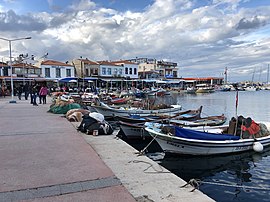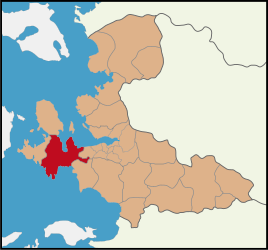Urla, İzmir
Urla | |
|---|---|
District and municipality | |
 | |
 Map showing Urla District in İzmir Province | |
| Coordinates: 38°19′20″N 26°45′53″E / 38.32222°N 26.76472°E | |
| Country | Turkey |
| Province | İzmir |
| Government | |
| • Mayor | Murtaza Dayanç |
| Area | 727 km2 (281 sq mi) |
| Population (2022)[1] | 74,736 |
| • Density | 100/km2 (270/sq mi) |
| Time zone | UTC+3 (TRT) |
| Area code | 0232 |
| Website | www |
Urla is a municipality and
The name "Urla" is derived from the Greek Βουρλά ("Vourla") meaning marshlands and the town was cited as such in western sources until the 20th century. Bryela (Byzantine name meaning Woman of God i.e. Holy Maria) whereas it has been suggested that due to the transposition of vowels Bryela has become Vourla, meaning marshlands. Urla is where the ancient city of Klazomenai is located and its remains are much visited, while the name lives on in the unofficial appellation used in the region for part of the coastline of the district, "Kilizman" which is a still-used derivative of Klazomenai. (Former name of Güzelbahçe). With literacy among the highest in Turkey at 97%, Urla is also home to İzmir Institute of Technology. Urla prides itself for having raised two important men of letters, Giorgos Seferis and Necati Cumalı.
Geography
The district center is located in the middle of the isthmus of a small peninsula which protrudes northwards in the Gulf of İzmir, but its urban tissue is comparatively loose and extends eastwards to touch the coast and to cover a wide area which also includes a large portion of the peninsula. Sizable parts in the municipal area, owned by absentee landlords, remain uninhabited or are very rural in aspect. The peninsular coastline present a number of compounds constituted by seasonal residences along the beaches and the coves and which are administratively divided between Urla center's municipal area or its depending villages.
Urla district area's eastern end neighbors the westernmost district of the Greater Metropolitan Area of
Composition
There are 37
- Altıntaş
- Atatürk
- Bademler
- Balıklıova
- Barbaros
- Birgi
- Camiatik
- Çamlıçay
- Demircili
- Denizli
- Gülbahçe
- Güvendik
- Hacıisa
- İçmeler
- İskele
- Kadıovacık
- Kalabak
- Kuşçular
- M.Fevzi Çakmak
- Naipli
- Nohutalan
- Ovacık
- Özbek
- Rüstem
- Sıra
- Şirinkent
- Torasan
- Uzunkuyu
- Yağcılar
- Yaka
- Yelaltı
- Yeni
- Yenice
- Yenikent
- Zeytinalanı
- Zeytineli
- Zeytinler
Economy
| Enterprises in Urla | 2007 |
| Services | 592 |
| Industrial | 16 |
| Commerce | 1,200 |
| Exporters | 4 |
| Agricultural | 3,204 |
Secondary and/or seasonal residences continue to play a key role in Urla's economy, as demonstrated by the high number of residences (26,000 in all for the district) as compared to its population. Although Urla is keen to upgrade its arguments as a tourism destination with a wider appeal, the number of beds available in its accommodation units remains rather modest at only 185.
Urla's fish restaurants and other local specialties, notably a layered pastry called "katmer" is famous. Urla's name is also associated in Turkey with a particular breed of "okra", red in color, called "kınalı bamya" in Turkish.
While there are no large
In 2006, the district realized exports reaching 524,068 US Dollars, mostly agricultural products with added value. Some marble and lime is quarried but the contribution of mining activities to the general economy of the district is low. The same can be said for industrial activities in general, which are almost exclusively based on agriculture or livestock. The three small
| Fruit&vegetable production | 2006 (tonnes) |
| Olive (for olive oil) | 14,205 |
| Tomato (for table consumption) | 5,200 |
| Watermelon | 4,300 |
| Okra (red) | 3,700 |
| Olive (for table consumption) | 3,700 |
| Tomato (for sauce) | 2,600 |
| Artichoke | 1,500 |
| Grape (for table consumption) | 1,146 |
Satsuma
|
852 |
| Cabbage | 750 |
| Aubergine | 600 |
| Watermelon | 560 |
| Chili pepper | 420 |
| Lettuce | 340 |
| Broccoli | 250 |
| Grape (for wine) | 240 |
| Orange | 135 |
Nectarine
|
105 |
Agricultural production remains the determinant activity for much of the district. In the district's total agricultural area of 971.5
Agriculture based on
17 per cent of the district's land, although suitable for agriculture, is still unused currently.
In

There are 6 stock farms (horse breeding and care) and two enterprises engaged in dog breeding and care in Urla.
Education and Health
There are 16 students for each teacher and 492 patients for each doctor in Urla. [citation needed]
History
Limantepe
Information on Urla region's pre-
Klazomenai - Kilizman

Urla was an important cultural centre also in its
The oldest attested olive oil production facilities were recently discovered in Klazomenai. The traces also indicate first exports of olive oil by way of sea.
Olive oil extraction installation (işlik) dating back to the third quarter of the 6th century BC uncovered in Klazomenai is the only surviving example of a level and weights press from an ancient Greek city and precedes by at least two centuries the next securely datable earliest presses found in Greece.[5] It was restored and reconstructed in 2004-2005 through collaboration between Ege University, a Turkish olive-oil exporter and a German natural building components company, as well as by local artisans, on the basis of the clearly visible millstone with a cylindrical roller and three separation pits. The olive oil obtained turned out to be quite a success in business terms as well.
Turkish era
In the summit of Ottoman power, during the 16th century, Urla was almost entirely incorporated into the
Seferis and Cumalı
Urla had two important men of letters among his sons: It is the birthplace of the Greek poet and
Archaeology
In January 2021, archaeologists headed by Elif Koparal, announced the discovery of the ruins of a 2500 year-old temple of Aphrodite from the 5th century BC. Among other findings in and around the temple, they found a statue piece depicting a woman, a terracotta female head and an inscription that reads, "This is the sacred area".[9] The traces of the temple were first excavated in 2016.[10][11][12]
Notable people
- Soner Ergençay, Turkish football player
- Duygu Sakallı, Turkish handballer
- Giorgos Seferis, Greek poet and diplomat, Nobel Prize in Literature 1963
- Ecumenical Patriarchate
- Iakovos Tombazis & Emmanouil Tombazis, Greek revolutionaries with familial origins from Urla
Festivals
See also
References
- ^ TÜİK. Retrieved 12 July 2023.
- ^ Büyükşehir İlçe Belediyesi, Turkey Civil Administration Departments Inventory. Retrieved 12 July 2023.
- ^ "İl ve İlçe Yüz ölçümleri". General Directorate of Mapping. Retrieved 12 July 2023.
- ^ Mahalle, Turkey Civil Administration Departments Inventory. Retrieved 12 July 2023.
- ISBN 978-0-19-815288-0.
- ISBN 978-90-04-11485-2.
- ISBN 978-0-521-45908-2.
- The University of Wisconsin Press, p. 174-175
- ^ Ruins of Aphrodite Temple found in Urla
- ^ Gershon, Livia. "Archaeologists in Turkey Unearth 2,500-Year-Old Temple of Aphrodite". Smithsonian Magazine. Retrieved 2021-05-21.
- ^ January 2021, Patrick Pester-Staff Writer 12 (12 January 2021). "2,500-year-old temple to Greek love goddess unearthed in Turkey". livescience.com. Retrieved 2021-05-21.
{{cite web}}: CS1 maint: numeric names: authors list (link) - ^ Agency, Anadolu (2021-01-02). "2,500-year-old Aphrodite temple discovered in Turkey's Izmir". Daily Sabah. Retrieved 2021-05-21.
External links
Resources
- "Report: Urla, 33p" (PDF) (in Turkish). İzmir Chamber of Commerce. 2007. Archived from the original (PDF) on 21 October 2012.
- Urla's names as referred to by Dr. Mahmut Tolon


